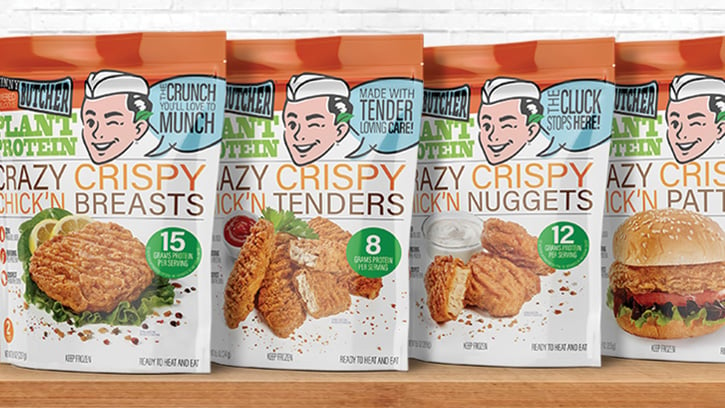Plant-Based Fare With a Side of Fun
Startups & Innovators | INNOVATIONS
Leave it to an entrepreneur who helped redefine one food category to have a decent shot at redefining another.
With his Skinny Butcher brand of plant-based chicken products already staring out at consumers from thousands of U.S. freezer cases since the brand’s debut last year, Dave Zilko is threatening to have his way in the alt-meat business, similar to how his previous company tipped over the salsa trade.
And in a lesson for other would-be entrepreneurs with intentions toward America’s better-for-you food business, Zilko’s strategy largely boils down to one thing: Have some fun with your brand.
“Impossible and Beyond have frozen ‘chicken’ products, but they are too earnest,” contends Zilko, cofounder and CEO of Skinny Butcher. With his late business partner, Jack Aronson, Zilko helped build and then sold the Garden Fresh Gourmet Salsa brand to Campbell Soup for $231 million in 2015.
“No one is doing an inventive brand generally in this space,” says Zilko. “Look at Impossible and Beyond: They’ve been merchandising themselves in the meat department of stores. We have positioned ourselves in frozen grocery, an established category, a 30-year category where Boca, Dr. Praeger, and MorningStar Farms have been for a long time. We’re just doing it with some fun.”
Following this philosophy, Skinny Butcher plant-based Crazy Crispy Chick’n Nuggets quickly became the No. 1 plant-based SKU in Walmart supercenter stores in the United States in a limited-time placement last year, outstripping Beyond Meat’s Beyond Chicken Nuggets. Since then, the brand’s retail presence is expanding through Costco warehouse stores, as well as a growing variety of supermarket chains, including H-E-B, Giant, and Gordon Food Services. Skinny Butcher plans a line of spicy alt-chicken nuggets and similar plant-based turkey and fish offerings for this year.
Of course, the alt-meat category has been anything but fun for the last few years since U.S. consumers began resisting repeat purchases of some of the brand leaders after responding more enthusiastically to them during the height of the pandemic. And there’s no guarantee yet that Skinny Butcher’s early momentum won’t fade as meat alternatives collectively struggle.
Pricing It Right
Pricing of a 9.5-ounce bag of Skinny Butcher Chick’n Nuggets typically is about $1 more than category leader MorningStar Farms, which is priced at about $4.50. “We want to be an affordable luxury,” Zilko says. “We’re Absolut [vodka], not Grey Goose.”
For Skinny Butcher, the “fun” that helps justify the price premium begins with “p”—as in a product that is highly differentiated from many other plant-based poultry analogues because it blatantly attempts to mimic the fried-chicken ethos.
Zilko started with imported bamboo fiber from Italy and added pea protein, a blend he believes gives his product edges in texture and health narratives over the soy base of many competitors. Skinny Butcher folds in a proprietary spice blend that masks pea protein’s aftertaste.
He worked for three years with Golden West Food Group, a major contract manufacturer in California, to develop a double-breading process that mimics KFC’s “extra crispy” varieties of chicken for Skinny Butcher nuggets, patties, and tenders.
“We’re proud of it,” says Zilko, citing Skinny Butcher’s victories in one taste test “cutting” after another with buyers from Costco and other retailers. “You really can’t tell it’s not animal protein.”
At the same time, Zilko was working hard on what he’s best at: the retailing and marketing side of the business. It started with the brand’s logo of a winking butcher, which plays off the humorous line, “Never trust a skinny butcher.” There’s also a new deal with a philanthropy that likely will significantly raise awareness of Skinny Butcher among U.S. consumers.
Also, early last year, Skinny Butcher joined with restaurant chain Lettuce Entertain You Enterprises to develop a menu of Crazy Crispy Chick’n products for Wow Bao, a fast-growing startup that stages third-party meal delivery out of underutilized spaces in restaurants, known as “dark kitchens” and “ghost kitchens.” Wow Bao has several hundred such operations now.
Betting on Mainstream
“Our brand aesthetic is to try to inject fun,” Zilko says. “You can be plant-based and [plant]-oriented, and be flexitarian, but still put a smile on people’s faces. I may be wrong. It’s a big bet. But we’re trying to pull mainstream people into the tent.”
Branding details extend to Skinny Butcher packaging, which is brightly colored and busy with verbiage. Bubbles cleverly express product- and brand-relevant “thoughts” from the butcher, such as, “Made with tender loving care” and “The cluck stops here.” Says Zilko, “It’s a fun way to communicate at point of sale.”
Skinny Butcher also is “looking for halo effects from cultural viral moments” like the brand’s tie-in last year with Stranger Things, a popular Netflix series.
Now Zilko is working with the brand’s “wink” logo. An imminent major marketing campaign with the not-for-profit No Kid Hungry initiative and partnering with iHeart Radio will give Skinny Butcher access to celebrities who will stage winks with its nuggets—and give hope to Zilko’s goal of creating iconic marketing moments.
“We want it to become reminiscent of the old ‘Got Milk?’ campaign” by the California Milk Processor Board in which celebrities were photographed bearing milk mustaches, Zilko says. “We want to own the wink like that white mustache.”



